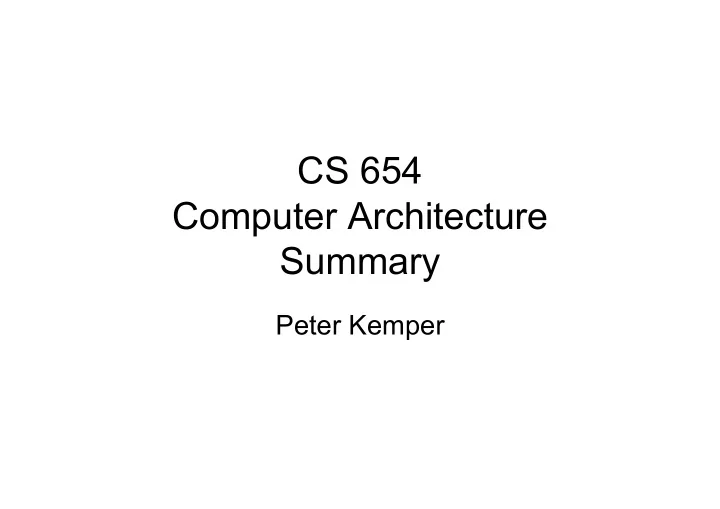

CS 654 Computer Architecture Summary Peter Kemper
Chapters in Hennessy & Patterson • Ch 1: Fundamentals • Ch 2: Instruction Level Parallelism • Ch 3: Limits on ILP • Ch 4: Multiprocessors & TLP • Ap A: Pipelining • Ap C: Memory Hierarchy • Ap F: Vector Processors
C1: Fundamentals • Computer Architecture: – Topic: • Designing the organization and hardware to meet goals and functional requirements and to succeed with changing technology • Not just ISA – Technology trends: Bandwidth over latency, scaling of transistors and wires, power in ICs, cost, dependability – Measuring, Reporting, Summarizing Performance – Quantitative Principles • Take advantage of parallelism • Principle of locality • Focus on common case • Amdahl’s law • Processor performance equation
C1: Fundamentals • Formulas: – CPU time, Amdahl’s law, Power dynamic & static, Average memory access time, Availability, Die yield, Misses per instruction, Cache index size, Means (arithmetic, geometric -> Benchmarks) • Rules of Thumb: – Amdahl/Case Rule, 90/10 locality rule, bandwidth rule, 2:1 Cache rule, dependability rule Check short list inside book cover!
Ap A: Pipelining • Key idea: – Split up work in a sequence of steps, work along stages in a piecemeal manner, start next instruction as soon as previous one proceeded far enough • RISC, load/store architecture • Challenges: – Hazards: Data (RAW,WAW,WAR), Control, Structural • Focus: – CPI: get average value as small as possible • Close to 1 • Less than 1 • Means to reduce pipeline stalls ?
Ap A: Pipelining Means to reduce pipeline stalls ? • Fetching: – Prefetching, Branch prediction, Caches (TLB, BTB) • Decoding – Decode (Trace cache), Issuing (Multi-issue) • Execution – Forwarding – Trouble: multicycle instructions (FP) • Memory – Forwarding (trouble: data dep for load & successor) • Write-back – Write first half of cycle (to have reads in 2nd half) Scheduling: Static vs dynamic
Ap C: Memory Cache organization – direct mapped, fully associative, n-way set assoc, – write through vs write back, write alloc vs no-write alloc – layered, dimensions, speed, inclusion property, – size of cache lines, tags, control bits/flags – Misses: 4 C’s • Address transformation – Virtual memory -> Physical address • Access in parallel with TLB – Virtually indexed, physically tagged • Average memory access time = Hit time + Miss rate * Miss penalty Formula extends to multiple layers Does out of order execution help?
Ap C: Memory 6 Basic Cache Optimizations in 3 categories • Reducing the miss rate: larger block size, larger cache size, higher associativity • Reducing the miss penalty: multilevel caches, reads get priority over writes • Reducing time to hit the cache: avoid index translation when indexing the cache Misses: compulsory, capacity, conflict, coherence
C 2: ILP Challenge: – Reorganize execution of instructions to utilize all units as much as possible to speed up calculations Obstacles: Hazards: Control, Functional, Data (RAW,WAW,WAR) Options: – Compiler techniques: loop unrolling – Branch prediction, static, dynamic, branch history table, 2-bit prediction scheme, local vs global/correlating predictor, tournament predictor – Dynamic scheduling, hardware based speculation • Tomasulo: reservation station, common data bus, register renaming, issue in order, exec ooo, complete ooo, precise exceptions? • Tomasulo + speculation: ROB, commit in order • Register renaming – Multiple Issue • Statically/dynamically scheduled super scalar processor, VLIW processors – Instruction delivery and speculation, BTB
C 3: ILP limits Simulation study to evaluate design space: • Register renaming • Branch prediction, jump prediction • Memory address alias analysis • Perfect caches Spec benchmarks: limited ILP potential More realistic assumptions reduce potential even further • Limited window size, maximum issue count • Realistic branch and jump prediction • .. Also: uniform & extremely fast memory access
C 3: ILP limits Superscalar processors & TLP: • Coarse-grained, fine-grained and simultaneous multithreading • Challenges: – Larger register file – Not affecting clock cycle (issue & commit stages) – Cache & TLP conflicts do not degrade performance • Moderate level of TLP can be supported with little extra HW effort – Example Power4 -> Power5 with SMT • Future trends: – superscalar processors to expensive to push further – Also wrt power consumption -> Multiproc, multicore
C 4: Multiprocessors & TLP • Flynn’s taxonomy • Centralized shared-memory vs distributed memory multiprocessor design • Cache coherence – Snooping protocol vs directory-based protocol – 3 state finite state machine / automaton – Per cache line, (also memory for directory) – Reacts on CPU read/write requests – Reacts on bus read miss,write miss, invalidate requests – Cache can contain no data, right data, wrong data and be in state invalid, shared, exclusive – Coherence traffic increases with #processors, does not decrease with larger size of cache
C 4: Multiprocessors & TLP • Synchronization – Primitives: exchange, test&set, fetch&increment Implemented with – Pair of instructions: load linked, store conditional Implementing locks with primitives – Spin locks Used to protect access to monitor/lock that synchronizes threads and keeps queue of waiting threads e.g. in Java
Ap F: Vector processors • ISA includes vector operations & vector registers (Also in ordinary processors: SSE and Altivec for short vectors) • Code: – Concise: single instructions carries a lot of work to do – No dependencies inside vector operation – Stripmining • Memory access – Regular (possible with constant strides) for load & store • Functional units – Accesses same units, allows for lanes to parallelize • Execution: – Vector chaining – Gather/scatter with indirect memory access – Conditional execution – Compress/expand operations
Recommend
More recommend